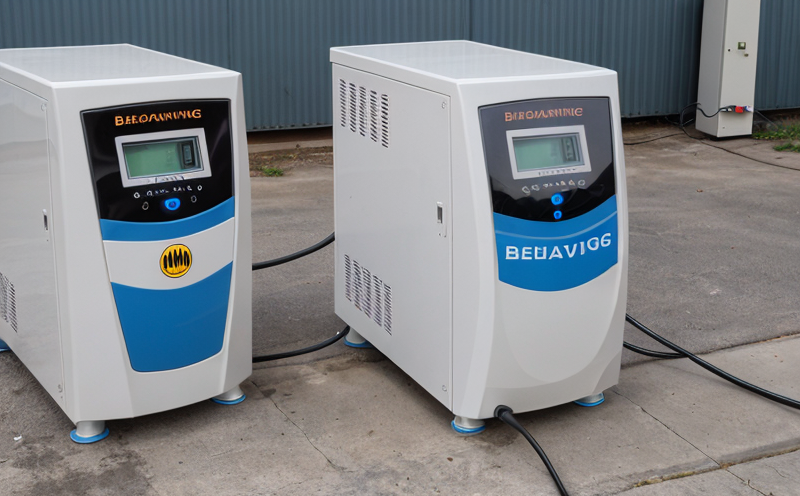IEC 62133-2 Charging and Discharging Testing of Portable Rechargeable Batteries
The IEC (International Electrotechnical Commission) 62133-2 standard provides stringent guidelines for the testing of portable rechargeable batteries, focusing particularly on their charging and discharging behavior. This standard is crucial for ensuring that batteries used in portable devices like mobile phones, laptops, power tools, and medical equipment meet safety and performance requirements.
The testing under IEC 62133-2 involves a series of procedures to assess the battery's ability to withstand repeated charging cycles without degradation. This includes evaluating the maximum voltage during charge, minimum voltage during discharge, and ensuring that the battery does not overheat or lose capacity over time. The standard also addresses the safety aspects such as preventing short circuits, overheating, and potential fire hazards.
The test setup typically involves a controlled environment where batteries are subjected to various charging and discharging protocols. This includes setting specific charge rates, discharge rates, and temperature conditions to mimic real-world usage scenarios. Testing is conducted at different temperatures to ensure the battery's performance under both hot and cold conditions, which can significantly impact its lifespan and reliability.
For a quality manager or compliance officer, understanding these testing protocols is essential for ensuring that products meet international standards and are safe for end-users. For R&D engineers, this test provides critical data on how to optimize battery design and performance. Procurement teams also benefit from knowing the outcomes of such tests as they inform decisions about sourcing batteries that can withstand rigorous conditions.
The acceptance criteria under IEC 62133-2 are strict and designed to ensure high reliability and safety. Batteries must pass all specified tests without any failures or hazards. This includes maintaining voltage within acceptable limits, not exceeding the maximum temperature thresholds, and demonstrating consistent performance across multiple cycles.
In summary, IEC 62133-2 is a vital standard that ensures portable rechargeable batteries are safe and reliable. It provides clear guidelines for testing procedures, which help manufacturers produce high-quality products compliant with international standards. For those in the industry, understanding this test protocol is essential to ensure product safety, reliability, and compliance.
Why It Matters
The importance of IEC 62133-2 testing cannot be overstated, especially for manufacturers of portable electronic devices. Compliance with these standards ensures that batteries are safe, reliable, and perform consistently across various conditions. This is crucial not only from a safety perspective but also to protect brand reputation and customer trust.
From a consumer standpoint, knowing that the battery in their device has undergone rigorous testing provides peace of mind. It assures them that the product will function as expected without unexpected failures or hazards. For businesses, meeting these standards can open up new markets and enhance competitive advantage by demonstrating commitment to quality and safety.
The standard also plays a role in reducing environmental impact by promoting longer-lasting batteries with improved efficiency and reduced waste. This is increasingly important as consumers become more environmentally conscious and demand sustainable products. By adhering to IEC 62133-2, manufacturers contribute to the global effort towards sustainability and responsible production.
In conclusion, compliance with IEC 62133-2 testing is essential for ensuring product safety, reliability, and environmental responsibility. It helps protect brands, enhances customer trust, and supports sustainable practices in the industry.
Industry Applications
Mobile phones and smartphones, which rely heavily on rechargeable batteries to power their operations.
Laptops and tablets, where battery performance directly impacts user experience and device longevity.
Power tools that require high-capacity batteries for sustained operation in demanding environments.
Military electronics, including GPS devices and communication equipment, which must function reliably under various conditions.
Medical devices such as defibrillators and portable diagnostic tools that depend on battery performance for critical functions.
Consumer electronics like smartwatches and fitness trackers, where battery efficiency is a key differentiator in the market.
The common thread among these applications is the reliance on rechargeable batteries to function effectively. IEC 62133-2 testing ensures that these critical components meet stringent safety and performance standards, thereby enhancing the overall reliability of devices across various sectors.
Why Choose This Test
Selecting IEC 62133-2 for charging and discharging testing offers numerous advantages. Firstly, it provides a comprehensive evaluation of battery performance under controlled conditions, ensuring that the device functions correctly in all expected scenarios. This thorough testing helps identify potential issues early on, allowing manufacturers to make necessary improvements before product release.
Secondly, compliance with this standard enhances brand reputation and consumer trust. When consumers see that their devices have undergone rigorous safety checks, they are more likely to purchase products from reputable brands. This can lead to increased market share and customer loyalty.
Thirdly, IEC 62133-2 testing supports sustainable production practices by promoting the use of longer-lasting batteries. By ensuring that batteries meet these stringent standards, manufacturers contribute to reducing electronic waste and promoting a more responsible approach to product development.
In addition, this test protocol helps identify potential risks associated with battery failure or malfunction. Early detection allows for corrective actions to be implemented, thereby protecting both the manufacturer's interests and end-users' safety.
Lastly, adherence to IEC 62133-2 ensures compatibility across different devices and systems, facilitating seamless integration into larger networks of connected products. This interoperability is increasingly important as technology continues to evolve towards more integrated ecosystems.
In summary, choosing IEC 62133-2 for charging and discharging testing offers significant benefits in terms of product reliability, safety, sustainability, and market reputation. It is a critical step towards ensuring that portable rechargeable batteries perform optimally across various applications.





